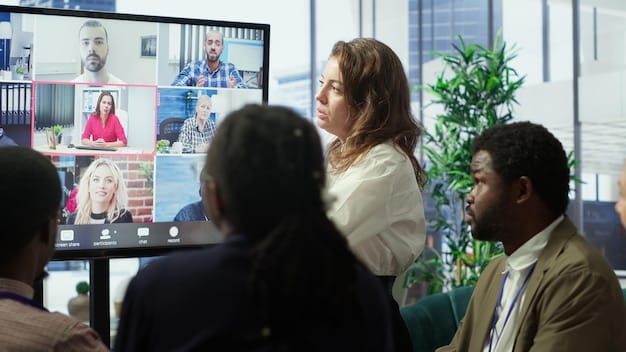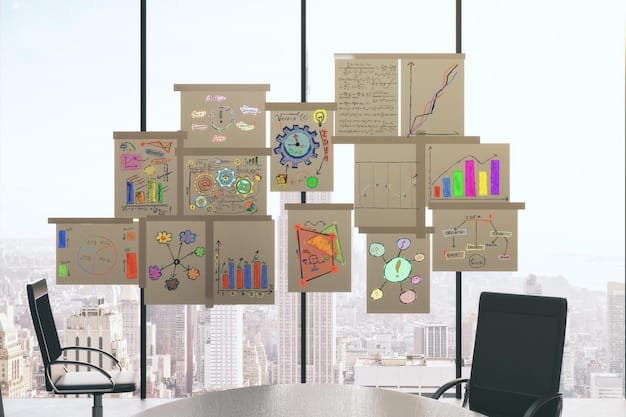Improve Remote Team Collaboration: Overcoming Communication Breakdown

Remote work communication breakdown can significantly hinder team collaboration. Fortunately, by implementing strategic approaches such as structured communication channels, regular feedback loops, clear documentation practices, and fostering a culture of open dialogue, teams can enhance collaboration efficiency by up to 30%.
In today’s digital age, remote work communication breakdown poses a significant challenge for teams striving to maintain seamless collaboration. But what if you could boost your team’s collaboration by 30%? Let’s explore effective strategies to overcome these hurdles and unlock your team’s full potential.
Understanding communication breakdown in remote work
Remote work presents various communication challenges that can lead to misunderstandings and inefficiencies. A clear understanding of the root causes is essential to implement effective improvements and enhance overall team performance.
The unique challenges of remote communication
Unlike in-office communication, remote interactions often lack the non-verbal cues that provide context and clarity. This can result in messages being misinterpreted, leading to frustration and delays.
- Reduced non-verbal cues: In-person communication relies heavily on body language, facial expressions, and tone of voice. Remote interactions often miss these vital cues, leading to potential misinterpretations.
- Technological barriers: Reliance on various digital tools can introduce complications such as connectivity issues, software glitches, and compatibility problems, hindering smooth and effective communication.
- Time zone differences: Teams spread across different time zones face challenges coordinating meetings and ensuring timely responses. These delays can disrupt workflow and impede collaborative efforts.

Recognizing these unique challenges is the first step in addressing communication breakdown and fostering a more collaborative remote environment. Understanding the specific hurdles your team faces enables you to implement tailored strategies that effectively bridge the communication gap.
Strategy 1: Structuring communication channels
Establishing well-defined communication channels is essential for ensuring that information flows smoothly and efficiently across your remote team. This approach helps team members understand where to seek information and how to engage with each other effectively.
Designating channels for specific purposes
Creating separate channels for different types of communication ensures that important messages don’t get lost and information is easily accessible. This strategic structuring enhances focus and productivity.
- Project-specific channels: Designate specific channels for different projects or initiatives. This keeps all relevant communication in one place, making it easier for team members to stay informed and contribute effectively.
- General communication channel: Maintain a channel for general announcements and non-urgent discussions. This ensures that everyone stays informed about company-wide updates without being overwhelmed by project-specific details.
- Social channel: Create a channel for casual conversations and team-building activities. This fosters a sense of community and camaraderie, which is crucial for maintaining team morale in a remote setting.
By structuring your team’s communication channels effectively, you minimize noise, enhance clarity, and facilitate smoother interactions. This focused approach contributes to increased efficiency and a more collaborative remote work environment.
Strategy 2: Implementing regular feedback loops
Feedback loops are critical for maintaining alignment, addressing concerns proactively, and ensuring continuous improvement within a remote team. Regular and constructive feedback helps team members stay on track and feel valued.
The importance of regular check-ins
Scheduled check-ins, both formal and informal, provide opportunities for team members to share updates, raise concerns, and receive guidance. These check-ins help maintain transparency and cohesion.
- Daily stand-ups: Initiate brief daily meetings for team members to share their progress, highlight any roadblocks, and align on daily priorities. These stand-ups promote accountability and keep everyone informed.
- Weekly one-on-ones: Schedule one-on-one meetings between team leads and their direct reports to discuss personal development, provide performance feedback, and address any challenges. These meetings foster a supportive environment and enhance employee engagement.
- Quarterly performance reviews: Conduct comprehensive performance reviews to assess individual and team performance, set goals, and identify areas for improvement. These reviews provide a structured framework for growth and development.
Implementing regular feedback loops ensures that your team remains aligned, motivated, and continuously improving. These structured interactions promote transparency, accountability, and a culture of continuous development, ultimately enhancing team collaboration in the remote work setting.
Strategy 3: Creating clear documentation practices
Comprehensive and easily accessible documentation is essential for ensuring that all team members have the resources they need to perform their tasks effectively. Clear documentation practices reduce confusion and empower team members to work independently.
Leveraging documentation for clarity
Documentation serves as a central repository for essential information, reducing reliance on individual team members for knowledge. This ensures continuity and consistency across the board.
- Centralized knowledge base: Establish a centralized location for storing and organizing all critical documents, such as project plans, standard operating procedures, and training materials. This ensures that information is easily accessible and consistently updated.
- Standardized formatting: Implement standardized formatting and naming conventions for all documents. This makes it easier for team members to locate and understand the information they need.
- Version control: Utilize version control systems to track changes to documents and ensure that everyone is working with the most up-to-date information. This minimizes confusion and reduces the risk of errors.

By implementing clear documentation practices, you empower your team to work more independently and confidently. This reduces the need for constant clarification, streamlines workflows, and promotes greater efficiency, driving improved team collaboration in the remote setting.
Strategy 4: Fostering a culture of open dialogue
Creating a work environment where open communication is encouraged and valued nurtures trust, transparency, and collaborative problem-solving. A culture of open dialogue ensures that team members feel comfortable sharing ideas, voicing concerns, and offering constructive feedback.
Encouraging open communications
Fostering a culture of open dialogue requires conscious effort to make team members feel safe and supported when expressing their thoughts and ideas. This creates an atmosphere of mutual respect and trust.
- Active listening: Promote active listening skills among team members to ensure that everyone feels heard and understood. Encourage team members to ask clarifying questions and summarize what they have heard to demonstrate understanding.
- Regular team meetings: Schedule regular team meetings specifically designed to facilitate open discussion and collaborative problem-solving. Create an agenda that allocates time for brainstorming, feedback, and addressing any team-related issues.
- Anonymous feedback mechanisms: Implement anonymous feedback mechanisms, such as surveys or suggestion boxes, to allow team members to voice concerns and provide feedback without fear of retribution. This can uncover issues that might not otherwise be addressed.
By fostering a culture of open dialogue, you empower your team to communicate more effectively, resolve conflicts constructively, and collaborate more seamlessly. This contributes to a more positive and productive remote work environment, driving improved team collaboration and achieving shared goals.
Measuring the impact of implemented strategies
To ensure that your strategies are effective, it’s essential to track key metrics that reflect the improvement in team collaboration. Regular measurement and analysis provide insights for continuous refinement.
Key performance indicators
Measuring specific performance indicators helps gauge the effectiveness of your communication strategies. These metrics provide tangible evidence of improvements and areas needing further attention.
- Project completion rates: Monitor the percentage of projects completed on time and within budget. Improvements in project completion rates indicate enhanced efficiency and better collaboration.
- Employee satisfaction scores: Conduct regular employee satisfaction surveys to gauge team morale and engagement levels. Higher satisfaction scores reflect a positive work environment and effective communication practices.
- Response times: Track the average response time to internal communications. Shorter response times indicate improved responsiveness and better coordination across the team.
Regularly monitoring and analyzing these key performance indicators enables you to assess the impact of your implemented strategies and make data-driven adjustments. This ensures that you are continuously optimizing your approach to enhance team collaboration in the remote work setting.
| Key Element | Brief Description |
|---|---|
| 📢 Structured Communication | Designate channels for different purposes to enhance focus and clarity. |
| 🔄 Regular Feedback Loops | Implement check-ins and performance reviews to maintain alignment. |
| 📚 Clear Documentation | Create a centralized knowledge base with standard formatting. |
| 🗣️ Open Dialogue | Encourage active listening and provide anonymous feedback mechanisms. |
Retractable FAQ Section
FAQ
▼
Communication breakdowns in remote teams often stem from a lack of non-verbal cues, technological barriers, and time zone differences. These factors can lead to misinterpretations and inefficiencies.
▼
Structured communication channels enhance remote team collaboration by designating specific channels for different purposes. This reduces noise, clarifies communication, and facilitates smoother interactions among team members.
▼
Regular feedback loops help remote teams stay aligned, motivated, and continuously improve. Scheduled check-ins promote transparency, accountability, and a culture of ongoing development and support.
▼
Clear documentation is crucial for remote collaboration because it provides team members with the resources they need to perform tasks effectively. Comprehensive and accessible documentation reduces confusion and enables independent work.
▼
Fostering a culture of open dialogue enhances remote collaboration by nurturing trust and transparency. It ensures that team members feel comfortable sharing ideas and voicing concerns, which leads to constructive problem-solving.
Conclusion
In conclusion, addressing remote work communication breakdown effectively involves implementing structured communication channels, fostering regular feedback loops, creating clear documentation practices, and nurturing a culture of open dialogue. By consistently applying these strategies, teams can significantly improve collaboration, enhance productivity, and achieve their goals in the remote work environment.





